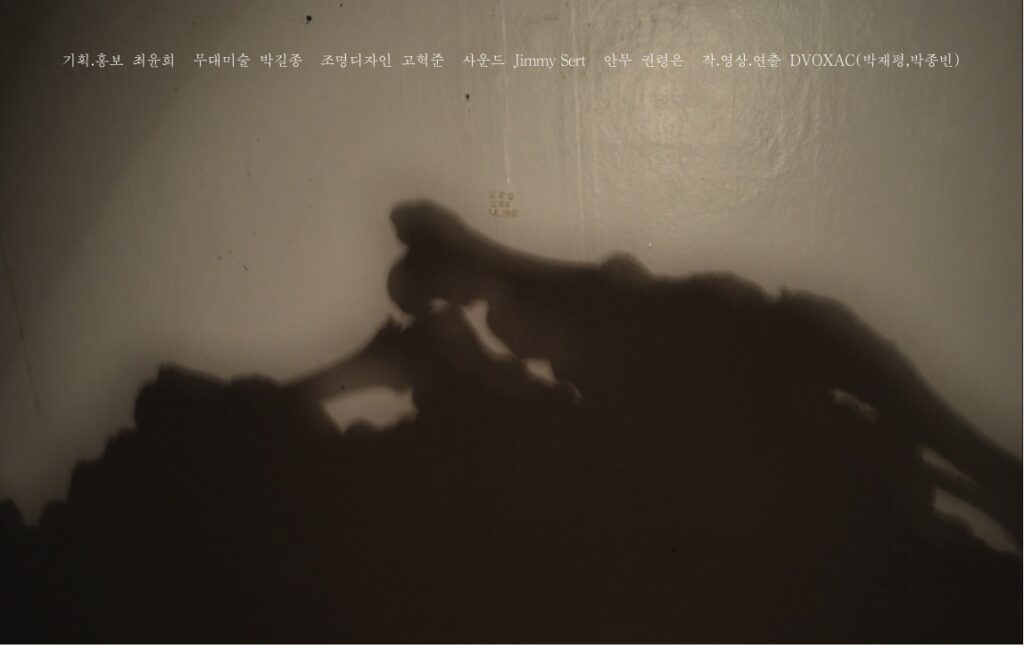

Performance: 40min / premiere on February 2014, Space Feelux, Arko Art Center, Seoul
Film : 42min (a part of feature film ‘Long Nights’ (80min), screening on May 2015, at Seoul Cinematheque )
집은 사생활, 일상, 정체성, 내러티브, 역사를 함축하는 사적인 공간이다. 우리는 집 안에 무대를 설치하고 자연재해로 고립된 개인의 이야기를 공연과 영상 두 가지 형식 으로 제작했으며, 이를 갤러리 공간에서 40분짜리 미디어 퍼포먼스로 재현했다. 이 작업에서 우리는 외부 현상의 영향과 미디어가 만들어내는 불안이 내부적으로 고립된 개인과 공간, 그들의 관계와 무의식을 어떻게 취약하게 만드는지에 대한 의문을 제기하고, 다음과 같은 질문을 고려했다.
집은 외부의 폭력이나 공포로부터 안전한 공간이 될 수 있는가?
이러한 공포는 조작된 상상인가, 아니면 실재하는 개념인가?
태풍으로 인해 생성되고 공유된 공포의 서사는 태풍과 함께 사라졌는가, 혹은 어딘가에 남아 있는가?
<전야>는 2012년 태풍 예보로 인해 사람들의 불안과 공포가 확산된 데서 모티브를 얻었다. 미디어가 만들어낸 거대한 태풍에 대한 공포는 쉽고 빠르게 사회에 퍼져나갔고, 사람들은 태풍에 대비하면서 두려워 하면서도 동시에 태풍의 파괴력에 대한 일종의 기대감을 가지고 태풍을 기다렸다. 또한 과거 태풍 피해에 대한 자료와 이미지도 대중의 불안감을 증폭시켰다. 태풍에 대비하기 위한 식료품과 생필품은 사재기로 인해 금세 동이 났고, 사람들은 대피소의 위치, 강풍에 창문이 깨지지 않도록 덕트 테이프로 창문을 밀봉하는 방법 등 대피 요령에 대한 정보를 인터넷에서 공유했다.
마침내 태풍이 한국을 통과했고, 일부 지역에서 재산과 인명 피해가 발생했지만 모두가 두려워하고 예상했던 종말적 상황은 아니었고, 사람들은 태풍 전후의 일을 금세 잊고 일상으로 돌아갔다. 하지만 창문의 찢어진 테이프, 강풍에 뒤집힌 쓰레기통에서 쏟아져 나온 쓰레기 더미, 길거리에 널브러진 나뭇가지와 낙엽 등 재난의 흔적과 기억의 파편이 일종의 낙인처럼 남아있었다. 실제로 태풍과 같은 자연재해나 기후 문제뿐만 아니라, 거의 매년 반복되는 남북 간 군사적 긴장 상황에서도 비슷한 현상이 나타난다. 이러한 사건들은 실제로 발생하지 않더라도, 사회 저변에 잠재된 무의식적 긴장이 지속되기 때문에 완전히 해소되지 않는 무력감과 불안감을 남긴다.
The home is a private space that implies intimacy, routine, identity, narrative, and history. We built a stage in our house and developed two forms of performance and film about individuals isolated by natural disasters, which we reconstructed in a 40-minute multimedia performance in the gallery. In developing this work, we questioned how external phenomena and media-induced fears make isolated individuals, spaces, relationships, and the subconscious vulnerable, and posed the following questions:
Can the home be considered a safe space from external violence or fear?
Is fear an imaginary perception or a real phenomenon?
Does the fear triggered by a typhoon or war disappear with the event’s end, or does it persist somewhere?
The work was motivated by the typhoons predicted for 2012, which caused widespread fear and panic among people. The fear of a massive typhoon, fueled by the media, quickly spread through society. People prepared for the storm with both fear and a certain anticipation of its destructive power. Documentation and images of damage caused by past typhoons amplified public anxiety. Supplies and food for typhoon preparation quickly sold out due to hoarding, and people shared information online about evacuation centers and emergency plans, like how to tape windows to prevent them from shattering in strong winds. Ultimately, the typhoon passed over South Korea, and while some regions experienced damage and casualties, it wasn’t the apocalyptic scenario that everyone feared and expected. People quickly forgot what had happened before and after the typhoon and returned to their daily lives. But traces remained: torn tape on windows, piles of trash spilling from overturned bins, branches and leaves covering the streets — remnants of the disaster, fragments of memory, like a kind of stigma. Similar phenomena occur not only with natural disasters like typhoons but also with the nearly annual military tensions between North and South Korea. Even without a concrete incident, subconscious tensions linger beneath the surface of society, leaving behind a sense of helplessness and unresolved fear.